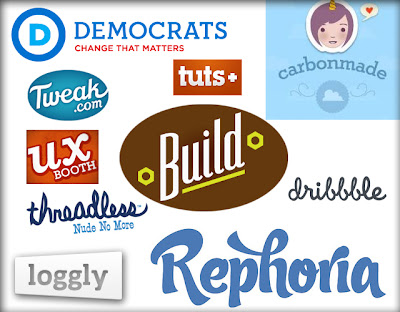 "A logo is really the first core message, the identity, that any brand provides to the world. And it has to be a logo that will work not just on a website homepage and on business cards but also as its Twitter or Facebook icon. So, you want it be distinctive and yet simple at the same time." (O,Dell, 2011)
"A logo is really the first core message, the identity, that any brand provides to the world. And it has to be a logo that will work not just on a website homepage and on business cards but also as its Twitter or Facebook icon. So, you want it be distinctive and yet simple at the same time." (O,Dell, 2011)
Sounds simple, but how many iterations does one well-made logo go through before it achieves the ideal representation of a company's product/services and culture? As a designer, the research into what makes an organization's personality could be a lengthy, but necessary, step before even approaching the challenges that come with the actual design of a logo. One small image requires a lot of legwork.
Design Mortality:
One important thing to keep in mind about logo & symbol design is shelf life. How will the image hold up against the test of time?
Branding can make or break a company. Think about the logos you are exposed to on a daily basis. When well constructed, they can be almost invisible yet subconsciously recognizable (logo game anyone? http://www.sporcle.com/games/g/corplogos); if poorly constructed they stick out like a sore thumb and repel any potential clients. Have you ever thought less of a company because of the quality of their marketing? Does it diminish the credibility in your eyes?
As mentioned in the article, especially when referring to web-based materials, the web is constantly changing. Therefore, a webpage from 10 years ago looks nothing like a webpage designed today. Here is an article observing trends in logos. This is over 2 years old, do you think they still hold true? Or have logos changed with the times?
http://mashable.com/2010/09/28/web-logo-design-trends/
The Designing Process:
The following link gives a brief rundown of 33 tools broken into 3 categories: Inspiration, Design, and Development.
http://mashable.com/2011/05/14/dev-design-resources-2/
This is an AWESOME resource. 100 different sources of inspiration:
http://mashable.com/2009/03/16/design-inspiration/
Do you have any tools you regularly reference/use? Web-based or otherwise?
References:
Chapman, C. (2009). 100 Great Resources for Design Inspiration. Mashable. Retrieved February 1, 2013. From http://mashable.com/2009/03/16/design-inspiration/
Hernandex, B.A. (2011). 33 Essential Resources for Developers and Designers. Mashable. Retrieved February 1, 2013. From http://mashable.com/2011/05/14/dev-design-resources-2/
O'Dell, J. (2010). 11 Trends in Web Logo Design: The Good, the Bad and the Overused. Mashable. Retrieved February 1, 2013. From http://mashable.com/2010/09/28/web-logo-design-trends/
Image Sources:
Logos: http://mashable.com/2011/03/24/logo-design-fundamentals/
Toolbox: http://www.sleekdesignstudio.com/perch/resources/toolboxwithicons-.jpg










